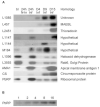Analysis of the Plasmodium and Anopheles transcriptomes during oocyst differentiation
- PMID: 14627711
- PMCID: PMC4674691
- DOI: 10.1074/jbc.M307587200
Analysis of the Plasmodium and Anopheles transcriptomes during oocyst differentiation
Abstract
Understanding the life cycle of the malaria parasite in its mosquito vector is essential for developing new strategies to combat this disease. Subtractive hybridization cDNA libraries were constructed that are enriched for Plasmodium berghei and Anopheles stephensi genes expressed during oocyst differentiation on the midgut. Sequencing of 1485 random clones led to the identification of 1137 unique expressed sequence tags. Of the 608 expressed sequence tags with data base hits, 320 (53%) had significant matches to the non-redundant protein data base, whereas 288 (47%) with matches only to genomic data bases represent novel Plasmodium and Anopheles genes. Transcription of six novel parasite genes and two previously identified asexual stage genes was up-regulated during oocyst differentiation. In addition, the mRNA for an Anopheles fibrinogen domain gene was induced on day 2 after an infectious blood meal, at the time of ookinete to oocyst differentiation. The subcellular distribution of MAEBL, a sporozoite surface protein, is developmentally regulated from presumed storage organelles in day 15 oocysts to uniform distribution on the surface in day 22 oocysts. This redistribution may reflect a sporozoite maturation program in preparation for salivary gland invasion. Furthermore, apical membrane antigen 1, another parasite surface molecule, is translationally regulated late in sporozoite development, suggesting a role during infection of the vertebrate host. The present results and those of an accompanying report (Abraham, E. G., Islam, S., Srinivasan, P., Ghosh, A. K., Valenzuela, J., Ribeiro, J. M., Kafatos, F. C., Dimopoulos, G., & Jacobs-Lorena, M. (2003) J. Biol. Chem. 279, 5573-5580) provide the foundation for studies seeking to understand at the molecular level Plasmodium development and its interactions with the mosquito.
Figures






Similar articles
-
Analysis of the Plasmodium and Anopheles transcriptional repertoire during ookinete development and midgut invasion.J Biol Chem. 2004 Feb 13;279(7):5573-80. doi: 10.1074/jbc.M307582200. Epub 2003 Nov 19. J Biol Chem. 2004. PMID: 14627712
-
The dynamics of interactions between Plasmodium and the mosquito: a study of the infectivity of Plasmodium berghei and Plasmodium gallinaceum, and their transmission by Anopheles stephensi, Anopheles gambiae and Aedes aegypti.Int J Parasitol. 2003 Aug;33(9):933-43. doi: 10.1016/s0020-7519(03)00112-7. Int J Parasitol. 2003. PMID: 12906877
-
Salivary gland transcriptome analysis during Plasmodium infection in malaria vector Anopheles stephensi.Int J Infect Dis. 2009 Sep;13(5):636-46. doi: 10.1016/j.ijid.2008.07.027. Epub 2009 Jan 6. Int J Infect Dis. 2009. PMID: 19128996
-
SOAP, a novel malaria ookinete protein involved in mosquito midgut invasion and oocyst development.Mol Microbiol. 2003 Jul;49(2):319-29. doi: 10.1046/j.1365-2958.2003.03566.x. Mol Microbiol. 2003. PMID: 12828632
-
Inference of the oxidative stress network in Anopheles stephensi upon Plasmodium infection.PLoS One. 2014 Dec 4;9(12):e114461. doi: 10.1371/journal.pone.0114461. eCollection 2014. PLoS One. 2014. PMID: 25474020 Free PMC article.
Cited by
-
Plasmodium sporozoite invasion of the mosquito salivary gland.Curr Opin Microbiol. 2009 Aug;12(4):394-400. doi: 10.1016/j.mib.2009.06.010. Epub 2009 Jul 14. Curr Opin Microbiol. 2009. PMID: 19608457 Free PMC article. Review.
-
Recent advances in recombinant protein-based malaria vaccines.Vaccine. 2015 Dec 22;33(52):7433-43. doi: 10.1016/j.vaccine.2015.09.093. Epub 2015 Oct 11. Vaccine. 2015. PMID: 26458807 Free PMC article. Review.
-
Characterization of a protozoan Phosducin-like protein-3 (PhLP-3) reveals conserved redox activity.PLoS One. 2018 Dec 31;13(12):e0209699. doi: 10.1371/journal.pone.0209699. eCollection 2018. PLoS One. 2018. PMID: 30596727 Free PMC article.
-
Reality check for malaria proteomics.Genome Biol. 2009;10(2):211. doi: 10.1186/gb-2009-10-2-211. Epub 2009 Feb 26. Genome Biol. 2009. PMID: 19291264 Free PMC article. Review.
-
Antibodies against MAEBL ligand domains M1 and M2 inhibit sporozoite development in vitro.Infect Immun. 2004 Jun;72(6):3604-8. doi: 10.1128/IAI.72.6.3604-3608.2004. Infect Immun. 2004. PMID: 15155670 Free PMC article.
References
-
- Abraham EG, Islam S, Srinivasan P, Ghosh AK, Valenzuela J, Ribeiro JM, Kafatos FC, Dimopoulos G, Jacobs-Lorena M. J. Biol. Chem. 2003;279:5573–5580. - PubMed
-
- Breman JG, Egan A, Keusch GT. Am. J. Trop. Med. Hyg. 2001;64(Suppl. 1):4–7. - PubMed
-
- Ghosh A, Edwards MJ, Jacobs-Lorena M. Parasitol. Today. 2000;16:196–201. - PubMed
-
- Sinden RE. In: Malaria: Parasite Biology, Pathogenesis, and Protection. Sherman IW, editor. American Society for Microbiology; Washington, D. C.: 1998. pp. 25–49.
-
- Menard R, Sultan AA, Cortes C, Altszuler R, van Dijk MR, Janse CJ, Water AP, Nussenzweig RS, Nussenzweig V. Nature. 1997;385:336–340. - PubMed
Publication types
MeSH terms
Substances
Associated data
- Actions
- Actions
- Actions
- Actions
- Actions
- Actions
- Actions
- Actions
Grants and funding
LinkOut - more resources
Full Text Sources

